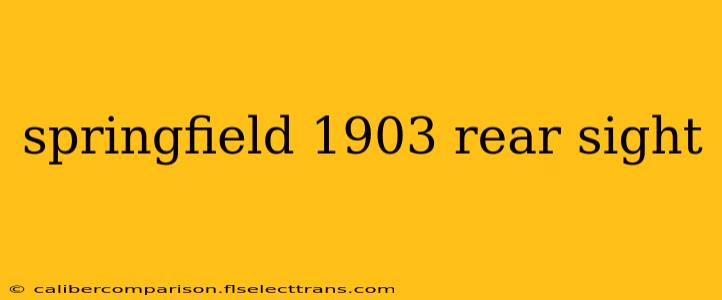The Springfield 1903 rifle, a legendary firearm in American history, is renowned for its accuracy and reliability. A key component contributing to its precision is the rear sight. Understanding its intricacies, adjustments, and potential issues is crucial for both collectors and shooters. This comprehensive guide delves into the specifics of the Springfield 1903 rear sight, providing detailed information for enthusiasts of all levels.
Understanding the Springfield 1903 Rear Sight Mechanism
The rear sight on the Springfield 1903 is a leaf-type sight, meaning it's a hinged, adjustable element that sits atop the receiver. This design allows for adjustments in both elevation and windage, crucial for accurate long-range shooting. Unlike simpler sights, the 1903's rear sight offers a degree of sophistication allowing for precise adjustments to compensate for bullet drop at various distances and wind drift.
Key Components:
- Leaf: The main adjustable part of the sight. It features graduations for elevation adjustments, typically ranging from 200 yards to 2800 yards (though the effective range is much shorter depending on ammunition and conditions).
- Aperture: The small hole through which the shooter aims. The size and shape of the aperture can influence sight picture and target acquisition. Some variations existed across different production runs.
- Slide/Tang: The mechanism that allows for elevation adjustments. The leaf is moved along this via a sliding mechanism.
- Windage Screw: A small screw located at the base of the leaf, allowing for horizontal (windage) adjustments.
- Base: The fixed part of the sight, attached to the receiver.
Adjusting the Springfield 1903 Rear Sight
Proper adjustment of the Springfield 1903 rear sight is paramount for achieving accurate shots. Here’s a step-by-step guide:
Elevation Adjustment:
- Zeroing the Rifle: Start by zeroing your rifle at a known distance, typically 100 yards. This involves firing several shots and observing where the bullet impacts relative to your point of aim.
- Adjusting the Leaf: Based on where your shots are landing (high or low), move the leaf accordingly. The graduations on the leaf indicate the yardage adjustment. Turning the leaf towards the higher numbers increases the elevation, compensating for bullet drop at longer ranges.
- Iterative Process: This is an iterative process, requiring multiple shots and adjustments until the point of impact matches your point of aim.
Windage Adjustment:
- Observe Shot Grouping: After zeroing for elevation, examine your shot group for horizontal dispersion.
- Adjusting the Windage Screw: The windage screw allows for minute horizontal corrections. Turning the screw will move the leaf left or right. Experiment with small adjustments and fire additional shots to refine the windage.
Important Note: Always use proper safety precautions when handling firearms. Consult a qualified firearms instructor for guidance if you are unfamiliar with adjusting firearm sights.
Common Issues and Troubleshooting
Over time, the Springfield 1903 rear sight can experience some wear and tear. Here are some common issues and their possible solutions:
- Loose Leaf: A loose leaf can significantly impact accuracy. Tightening the leaf's securing mechanism often resolves this.
- Bent Leaf: A bent leaf requires careful straightening; however, this is best left to a gunsmith to prevent further damage.
- Damaged Aperture: A damaged aperture can affect sight picture. Replacement may be necessary.
- Sticking Mechanism: If the elevation adjustment mechanism is sticking, cleaning and lubrication may help.
Conclusion
The Springfield 1903 rear sight is a crucial element of this iconic rifle. Understanding its functionality, adjustment procedures, and potential problems is vital for any owner or enthusiast. This detailed guide provides a foundation for confident and accurate shooting with your Springfield 1903. Remember, safe handling and proper maintenance are essential for preserving both the historical significance and shooting performance of this remarkable firearm.

